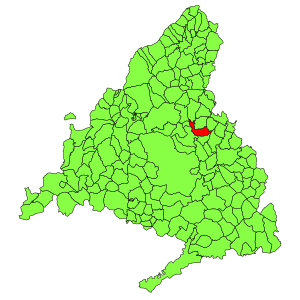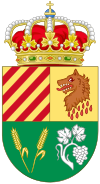Algete facts for kids
Quick facts for kids
Algete
|
|||
|---|---|---|---|
| Villa de Algete | |||
|
|||

Location of Algete in Madrid
|
|||
| Country | |||
| Autonomous community | Madrid | ||
| Province | Madrid | ||
| Comarca | Cuenca del Medio Jarama Comarca | ||
| Judicial district | Torrejón de Ardoz | ||
| Area | |||
| • Total | 37.88 km2 (14.63 sq mi) | ||
| Elevation | 741 m (2,431 ft) | ||
| Population
(2018)
|
|||
| • Total | 20,473 | ||
| • Density | 540.47/km2 (1,399.81/sq mi) | ||
| Demonym(s) | Algeteños | ||
| Time zone | UTC+1 (CET) | ||
| • Summer (DST) | UTC+2 (CEST) | ||
| Postal code |
28110
|
||
Algete is a town and a "municipality" (which is like a local government area) in central Spain. It is part of the Community of Madrid, which is one of Spain's self-governing regions. Algete is about 30 kilometers (18.6 miles) northeast of Madrid, the capital city. In 2022, about 20,767 people lived there.
Contents
History of Algete
People have lived in the area around Algete for a very long time.
- Scientists have found signs of human settlements from the Iron Age near the Jarama River.
- Remains of old Roman villas and settlements from the Visigoth period have also been discovered.
Early Settlements
We know that people lived here during the time of the Arabs in Spain. They built qanat, which are special underground channels to bring water. The name Algete might come from the Arabic word "Al-Satt," meaning "the bank," likely referring to the Jarama River.
In 1081, King Alfonso VI started to take back the Jarama River area from the Muslims. He brought Christians from the south to live there.
Becoming a Town
In the 1500s, Algete officially became a town. The local church, called Asunción de Nuestra Señora, was rebuilt. It might have been built on top of an even older Romanesque church.
Later, in 1579, Pope Gregory XIII transferred Algete from the control of the Archbishop of Toledo to the King. Then, King Philip II sold the town for a lot of money to García Hurtado de Mendoza. He was a very important person, the Marqués de Cañete and Viceroy of Peru.
In 1728, King Philip V made Algete a "Duchy." This meant it was given special status to Christopher of Moscoso and Montemayor. At this time, Algete had about 290 families living in 282 houses. The number of people living there quickly grew to 1,263 in just a few years.
Modern Times
In the 1800s, King Alfonso XII visited Algete in 1883. The first public school for the town was built in 1891.
In the 1900s, during a difficult time in Spain, Algete was on the side of the Republic. Some religious items were damaged, and the church organ was destroyed.
In the 1960s, Algete began to grow and modernize.
- The first industrial areas were built.
- Water systems were improved.
- New highways were constructed.
- Street lighting was updated.
In the 1980s, a bullring and a sports center were built. In the 1990s, a new health center and more schools opened. During these years, many people moved to Algete from rural areas, causing the town to grow a lot.
Geography of Algete
Algete is located about 20 kilometers (12.4 miles) northeast of the modern areas of Sanchinarro and Las Tablas in Madrid. The town covers an area of 38 square kilometers (14.7 square miles).
The western part of Algete is a flat area where the Jarama River flows. The main town of Algete itself is located between some hills.
Natural Surroundings
Algete is surrounded by:
- Farm fields
- Eucalyptus forests
- Areas of scrubland (bushes and small trees)
It shares borders with several other towns:
- Fuente el Saz del Jarama
- San Sebastián de los Reyes
- Valdeolmos-Alalpardo
- Cobeña
- Daganzo de Arriba
- El Molar
- San Agustín del Guadalix
- Colmenar Viejo
The land in Algete is between 600 and 780 meters (1,968 and 2,559 feet) above sea level. The winter temperatures are usually colder than in the city of Madrid.
Town Areas
The places where people live in Algete can be divided into two main types:
- Residential developments (newer housing areas)
- The historic center (the older part of town)
Residential Areas
- Santo Domingo
- Prado Norte
- Ciudad Jardín Valderrey
Historic Centre Neighborhoods
The historic center has different neighborhoods, including:
- Palomares
- Retamar
- El Cigarral
- El Tesoro
- Pryconsa
- Los Pazos
- Castillo
- Las Letras
There are also some separate areas like Dehesa Nueva and industrial zones such as Rio de Janeiro, Los Nogales, and La Garza.
Bus Lines
Algete is connected to other towns and Madrid by several bus lines:
- 171: Madrid (Plaza de Castilla) - Santo Domingo urbanization (ALSA)
- 180: Alcobendas - Algete (Interbús)
- 181: Madrid (Plaza de Castilla) - Algete (Interbús)
- 182: Madrid (Plaza de Castilla) - Algete - Valdeolmos (Interbús)
- 183: Madrid (Plaza Castilla) - Cobeña - El Casar (Interbús)
- 185: Madrid (Plaza de Castilla) - Nuevo Algete (Interbús)
- 197: Madrid (Plaza de Castilla) - Torrelaguna (only one trip per day from Monday to Friday, stopping at Algete's high schools and ending in Talamanca de Jarama) (ALSA)
- 254: Valdeolmos - Fuente el Saz de Jarama - Alcalá de Henares (ALSA)
- 263: Madrid (Barajas) - Cobeña - Algete (Interbús)
Notable People
- Ángeles Ottein, a famous singer
Images for kids
See also
 In Spanish: Algete para niños
In Spanish: Algete para niños




